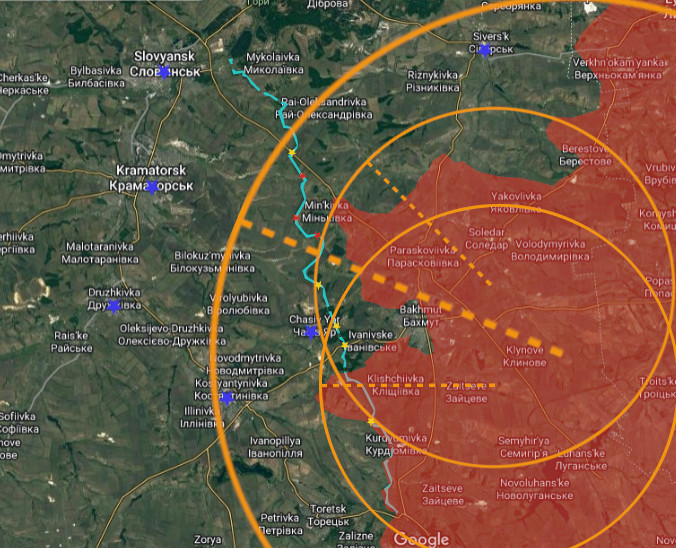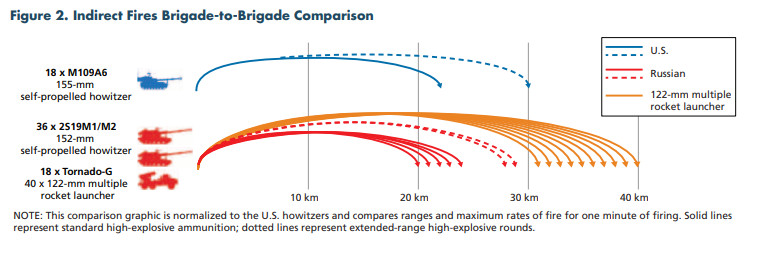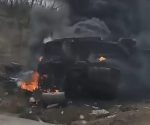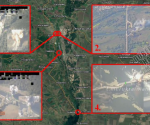The anti-Russian axis’ big propaganda and military defeats in Artyomovsk: Part One
The Ukrainians are trapped in Artyomovsk. There isn’t going to be any counter measure to relieve the city. The Ukrainians have a canal in between it and all but one their Human Wave staging areas, and Russian stand-off superiority has that covered – as shown in the very simple demonstration (not claiming to be accurate) below where the yellow stars are road bridges, red stars are other constructions that called be called crossings, and the orange circles and arcs and radial lines give an impression of Russian artillery coverage at 20km and 40km.
Indeed, the Ukrainians this month have been reporting shelling of Seversk, Slavyansk, Druzhkovka, Chasov Yar, Konstantinovka and Kramatorsk, showing the reach of Russian artillery is longer than this example allows. Additionally, with missile (or drone) strikes and their resultant spectacular explosions also reported in some of the aforementioned towns, the Russians are evidently acting to degrade Ukrainian “offensive” capability in its very (alleged) staging areas (blue stars) – or, from another perspective, weakening the next line of Ukrainian defence. The Ukrainians are trapped in Artyomovsk, and the Russians are gong to squeeze them out from east to west, killing them or taking them captive as they go. The propaganda projects of the anti-Russian axis’ myriad media outlets to impress that Artyomovsk is anything other than a straightforward, albeit big defeat for their side are going to be exposed for the lying they are.
So, let it be clear. There will be no relief of “Bakhmut” by the Ukrainians because of the very character of the opposing forces, plus the advantage of the terrain for Russia in that schema of relationship between the two. However, such is the state of alternative media, which could provide education, that the knowledge by which to confidently make this pronouncement appears to be a rare commodity.
To attempt to fix things – again – the author invites the reader to revisit the document that allowed him to be out from under the cloud of alternative media’s self-appointed geopolitical expert misinformation and disinformation. Please, consult the Rand Corporation paper, The Russian Way of Warfare, or at least the article which introduces it at this site and goes by the same name – to be found here. For our immediate purposes, it is enough to reproduce a few extracts from the paper, beginning with the following, which is taken from the conclusion:
Russia no longer has massive manpower advantages over its potential adversaries, nor can it trade space for time in light of the speed, range, and hitting power of modern aerial-delivered munitions.
Facing a future in which their traditional strengths are absent or less useful, Russia’s military leaders have adapted in ways designed to enable an effective defense of their homeland and, if required, to permit limited offensive operations around their periphery.
The Russian armed forces are not like the Soviet Army in size, depth, or global ideological aspirations. However, Russian forces have demonstrated an increasing array of conventional capabilities that would challenge adversaries at the tactical and operational levels of war.
It should be understood that the Rand analysis is wrong in ways that are not going to be gone into here. The important element to note is the non-interpretive remarks about the adaptation to deal with smaller amounts of manpower available to the Russian state, as opposed to that which had been to the Soviet Union.
The answer that the Russians came up with is all there to be read about in the aforementioned material, but to summarise very briefly, the Russians achieved smaller groupings of manpower which could achieve firepower greater to their NATO equivalents. A demonstration of this in the graphic below is in fact “Figure 2” from the Rand paper itself. To further illustrate, the following is from the Rand paper, put forth in the hope that no further explanation is needed and it is self-evident that the forward manoeuvring elements of Russian groupings are smaller than that of Western (therefore Ukrainian) counterparts:
A typical Western maneuver [sic] formation might have a single artillery or indirect fire subunit for each unit—for example, a U.S. Army brigade combat team has an organic artillery battalion—but Russian combined arms (tank or motor rifle) brigades have smaller maneuver [sic] elements and more numerous fire support elements. A motor rifle brigade, consisting of three motor rifle battalions and a tank battalion, will also frequently have two self-propelled artillery battalions, a rocket artillery battalion, and an antitank artillery battalion (with primarily direct fire systems) before it is augmented with additional artillery support from its parent formation.
There is also another facet of the self-containment of the Russian battle grouping in that not only can it cut a space into the land to support and protect its mobile, or manoeuvrable, components from the rear but it can do the same into the air above – as shown in the graphic below which is “Figure 1” from the Rand paper.
As it has now become absolutely clear, it was decided by the Ukrainians, or more likely their UK/US overlords, that some territorial gain might be had by running a massive force – which clearly would be unsupported by stand-off firepower – through the Russian gauntlet, and in doing so (especially at speed) isolate the outnumbered Russian forward mobile elements. The trade off (for what ultimately could only be morale-boosting to keep the Ukrainians in the fight until some hoped-for miracle could happen) would be huge casualties. Now, the Ukrainians were able to partially do this in Kharkov (in terms of territory, but definitely not in terms of Russians captured or killed), but they failed in Kherson (only occupying the city after the Russians had finished holding them off and had withdrawn), and they couldn’t even mount the same sort of attack intended to go into the Zaporozhye region (which the author has only just learnt to spell correctly).
Obviously, the Ukrainian operations that started at the end of August 2022, and which burnt out in the latter half of September, were devastating in terms of losses of men and materiel or else there would not have been the effort there has been to assemble what would be a third iteration of an Ukrainian army that would be required to complete the task in Zaporozhye. Incidentally, this history has already been written at FBEL – see, for instance, the article, The Offensive That Isn’t On 17th December: Russian Activity In The Kupyansk And Krasny Liman Directions – so repeating it is somewhat a waste of work except that it informs how the Ukrainians would have to try to attack the Russians at and around Artyomovsk.
The reason why the Ukrainians would even now not be able to mount a successful attack on Zaporozhye has aspects common to the difficulty to be experienced at Artyomovsk, most obviously the devastation of superior Russian stand-off fire capability. There has also since been the Russian partial mobilisation, and the redeployment from Kherson that means that concentrated Russian forward mobile elements are not necessarily going to be easily potentially overwhelmed, if at all. Specific to Zaporozhye are the defensive earthworks that the Russians have apparently been building, and of course at Artyomovsk the Ukrainians find that they would need to squeeze their massed ranks through tiny openings along a ~40 mile long stretch of waterway. Some of these are road crossings, some are constructions that look like they are not suitable for traffic, and some, in fact, (it seems) are small tracts of land underneath which the canal continues in tunnels (shown as gaps on the map above). These are forested where they occur near Chasov Yar, and don’t appear to be any good for staging a charge of armoured vehicles.
That there would be a military defeat for Ukraine in staging a “counter offensive” to relieve Artyomovsk is suggested by all the information. Defeat is so certain that no one should be concerned that the effort will be made – except for those whose business is it to worry people about such things. Speaking of which, the prospect of an anti-Russian axis propaganda defeat is too a certainty, as is the broader military defeat to come – consisting of, and preluded and represented by the fall of Artyomovsk – a defeat, in fact, that this article hasn’t even begun to explore. This is material for a Part Two.





















